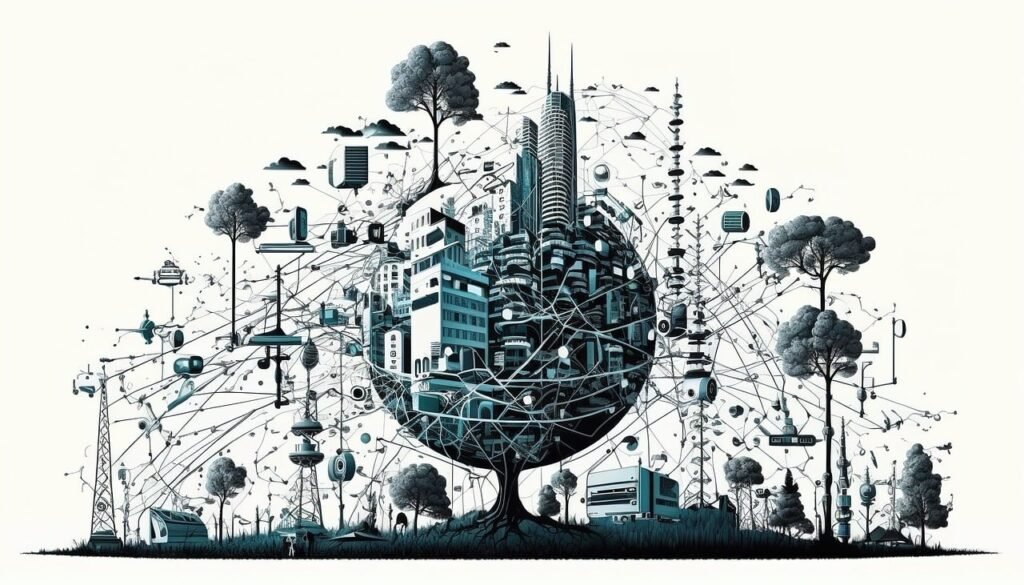Welcome to the world of IoT solutions for the healthcare industry! In today’s fast-paced and technologically advanced world, integrating IoT (Internet of Things) technology in healthcare has revolutionized the way patient data is collected, monitored, and analyzed. From wearable devices that track vital signs to smart hospital beds that prevent bedsores, IoT is transforming the efficiency and accuracy of healthcare delivery. Discover the endless possibilities and benefits of IoT solutions in healthcare as we delve into the integration of technology in this critical industry. Have you ever wondered how technology is revolutionizing the healthcare industry? From monitoring patients remotely to tracking medical equipment, IoT solutions are changing the way healthcare is delivered. In this article, we will explore the benefits of integrating IoT in the healthcare industry and how it is transforming the way healthcare is provided. Let’s dive in and discover the world of IoT solutions for the healthcare industry together.
Check out our Product Reviews
Understanding IoT in Healthcare
IoT, also known as the Internet of Things, refers to the network of physical devices, vehicles, appliances, and other objects embedded with sensors, software, and connectivity that enable them to connect and exchange data. In the healthcare industry, IoT is used to monitor patients, collect data, and improve the overall quality of care.
Imagine a world where your smartwatch can track your heart rate, sleep patterns, and activity levels, and automatically send that data to your healthcare provider. This is the power of IoT in healthcare, and the possibilities are endless.
How Can IoT Benefit the Healthcare Industry?
IoT solutions bring a wide range of benefits to the healthcare industry, including improved patient care, increased efficiency, cost savings, and better outcomes. By connecting devices and systems, healthcare providers can monitor patients remotely, track medical equipment, and streamline processes. This results in more personalized care, reduced errors, and faster response times.
Imagine being able to receive alerts when a patient’s vital signs are outside of normal ranges, or automatically reorder medications when supplies are running low. With IoT solutions, these scenarios are not only possible but becoming more common in healthcare settings around the world.
IoT Applications in Healthcare
The applications of IoT in healthcare are vast and diverse, ranging from remote patient monitoring to asset tracking and inventory management. Let’s explore some of the most common IoT applications in the healthcare industry and how they are being used to improve patient care and streamline operations.
Remote Patient Monitoring
Remote patient monitoring is one of the most widely adopted applications of IoT in healthcare. By using wearable devices, sensors, and mobile apps, healthcare providers can remotely monitor patients’ vital signs, medication adherence, and overall health status. This allows for early detection of health issues, timely interventions, and better management of chronic conditions.
Imagine being able to monitor a patient’s blood pressure, blood sugar levels, and medication adherence in real-time, without the need for frequent visits to the doctor’s office. With IoT solutions for remote patient monitoring, this level of care is possible, leading to improved patient outcomes and reduced healthcare costs.
Telemedicine
Telemedicine, also known as telehealth, is another key application of IoT in healthcare. By leveraging video conferencing, remote monitoring, and mobile technologies, healthcare providers can deliver care to patients in remote or underserved areas. This enables patients to access specialists, consultations, and follow-up care without the need for travel or long wait times.
Imagine being able to consult with a specialist from the comfort of your own home, without the need for a lengthy commute or scheduling conflicts. With telemedicine, this level of care is within reach for patients around the world, improving access to quality healthcare and reducing barriers to care.
Asset Tracking and Inventory Management
In addition to patient care, IoT solutions are also being used to track medical equipment, supplies, and inventory in healthcare facilities. By using RFID tags, sensors, and tracking systems, healthcare providers can monitor the location, usage, and maintenance of equipment, ensuring that it is always available when needed.
Imagine being able to locate a specific medical device or piece of equipment in a hospital with just a quick search on your smartphone. With IoT solutions for asset tracking and inventory management, healthcare providers can streamline operations, reduce waste, and improve efficiency, ultimately leading to better patient care and outcomes.

This image is property of pixabay.com.
Check out our Product Reviews
Challenges and Considerations
While the benefits of IoT in the healthcare industry are clear, there are also challenges and considerations that need to be addressed. From data security and privacy concerns to interoperability and regulatory requirements, healthcare providers must carefully navigate the complexities of implementing IoT solutions in their organizations.
Data Security and Privacy
One of the biggest challenges of implementing IoT in healthcare is ensuring the security and privacy of patient data. With the vast amount of sensitive information collected by IoT devices and systems, healthcare providers must take steps to secure data, encrypt transmissions, and comply with regulations such as HIPAA.
Imagine the potential impact of a data breach or cyberattack on a healthcare organization that is using IoT solutions to monitor patients and deliver care. By prioritizing data security and privacy, healthcare providers can mitigate risks, protect patient information, and maintain the trust of their patients.
Interoperability
Another challenge of IoT in healthcare is ensuring interoperability between devices, systems, and platforms. With the diverse range of technologies and vendors in the market, healthcare providers may face compatibility issues, integration challenges, and data silos that hinder the seamless exchange of information.
Imagine trying to sync data from a wearable device with an electronic health record system, only to encounter technical issues and delays. By addressing interoperability concerns, healthcare providers can ensure that IoT solutions work together effectively, share data in real-time, and improve communication and collaboration among care teams.
Regulatory Requirements
In addition to data security and interoperability, healthcare providers must also comply with regulatory requirements when implementing IoT solutions. From FDA regulations for medical devices to privacy laws such as GDPR, healthcare organizations must navigate a complex legal landscape to ensure compliance and mitigate risks.
Imagine the consequences of failing to meet regulatory requirements when deploying IoT solutions in a healthcare setting. By staying informed about regulations, seeking legal counsel, and following best practices, healthcare providers can protect themselves from liability, avoid fines, and uphold the highest standards of care.
Best Practices for Implementing IoT in Healthcare
To successfully integrate IoT solutions in the healthcare industry, healthcare providers should follow best practices, guidelines, and recommendations to ensure a smooth transition and optimal outcomes. By planning carefully, engaging stakeholders, and measuring results, healthcare organizations can unlock the full potential of IoT in healthcare.
Engage Stakeholders
Before implementing IoT solutions in healthcare, it is important to engage stakeholders, including clinicians, IT staff, administrators, and patients. By involving key players in the decision-making process, healthcare providers can gain valuable insights, identify needs, and build consensus around the goals and objectives of the project.
Imagine the impact of rolling out an IoT solution in a healthcare organization without consulting the end-users or involving front-line staff. By engaging stakeholders from the outset, healthcare providers can ensure that the solution meets the needs of the users, addresses real-world challenges, and delivers value to patients and providers alike.
Plan Carefully
To ensure the successful implementation of IoT solutions in healthcare, healthcare providers should plan carefully, define clear objectives, and establish metrics for success. By setting goals, timelines, and milestones, organizations can track progress, measure outcomes, and make informed decisions throughout the process.
Imagine embarking on a journey to implement IoT solutions in a healthcare organization without a clear plan or roadmap. By planning carefully, healthcare providers can avoid common pitfalls, address potential barriers, and stay on track to achieve their goals, ultimately leading to a successful deployment and positive impact on patient care.
Measure Results
After implementing IoT solutions in healthcare, it is important to measure results, evaluate outcomes, and continuously improve the system. By collecting data, analyzing performance, and gathering feedback from users, healthcare providers can identify areas for improvement, optimize processes, and ensure the ongoing success of the project.
Imagine investing time, resources, and effort into implementing IoT solutions in a healthcare organization, only to overlook the importance of measuring results and monitoring progress. By measuring results, healthcare providers can demonstrate the value of IoT, identify areas of strength and weakness, and make data-driven decisions to improve patient care and outcomes.

This image is property of pixabay.com.
Conclusion
In conclusion, IoT solutions are transforming the healthcare industry, improving patient care, streamlining operations, and revolutionizing the way healthcare is delivered. By leveraging IoT technologies, healthcare providers can monitor patients remotely, track medical equipment, and optimize processes, leading to better outcomes, reduced costs, and enhanced patient experiences.
As we continue to explore the possibilities of IoT in healthcare, it is crucial for healthcare providers to address challenges, follow best practices, and engage stakeholders to ensure a successful implementation. By working together, embracing innovation, and harnessing the power of IoT, the healthcare industry can unlock new opportunities, overcome obstacles, and shape the future of healthcare for generations to come. Thank you for joining us on this journey through the world of IoT solutions for the healthcare industry. Let’s continue to explore, learn, and innovate together.
Check out our Product Reviews